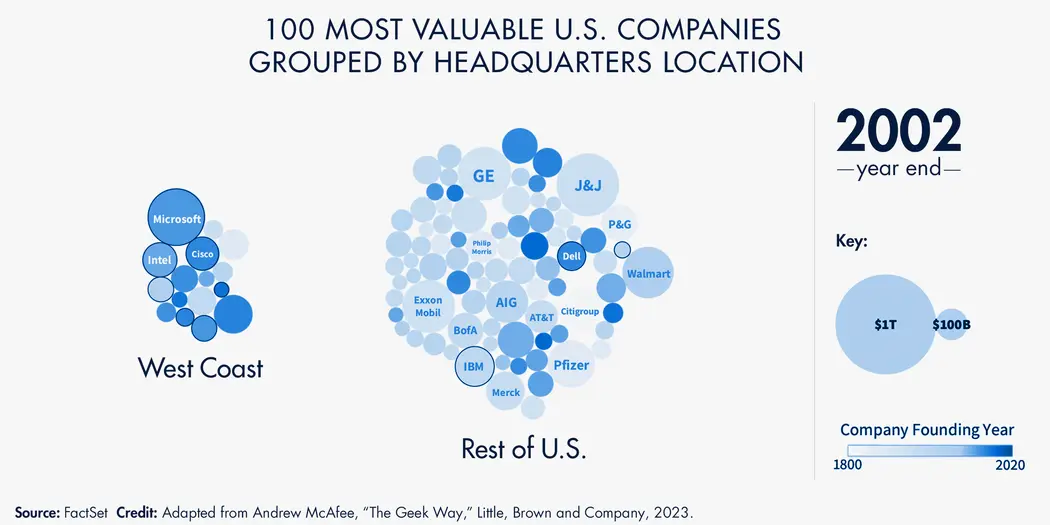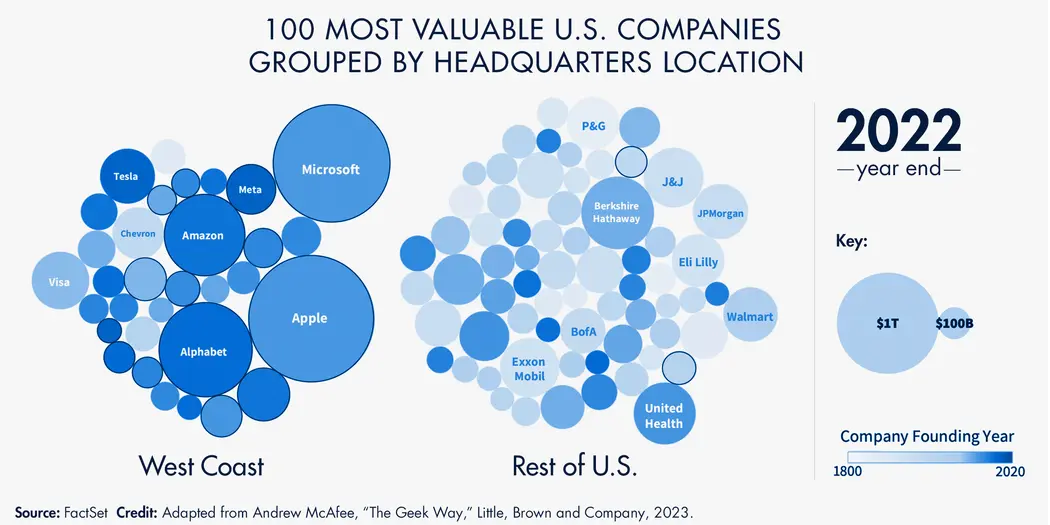Credit: Mimi Phan / Shutterstock
In his new book, “The Geek Way: The Radical Mindset That Drives Extraordinary Results,” MIT Sloan principal research scientist Andrew McAfee makes the case that self-avowed geeks, many of them working in the tech space, have created a new business culture that is “fast-moving, egalitarian, evidence-driven, argumentative, and autonomous.”
McAfee, co-director of the MIT Initiative on the Digital Economy, argues that the geek way of management delivers excellent performance while offering employees a work environment that features high levels of autonomy and empowerment.
In this excerpt, he presents evidence that geeks are building better companies — and that markets are valuing them more highly.
The excerpt has been edited for clarity and length.
++++++
Let’s look at my claim that geek companies are excellent performers. One way to test that claim is to see if the regions with the highest concentrations of geek companies also have the most high-performing companies. This test isn’t perfect — it could be the nongeek companies in those regions that are the high performers — but it does tell us if we’re on the right track.
For public companies, a prime measure of performance is market capitalization — how much they’re worth in the eyes of investors. If the geeks really are building better companies, then the market should be valuing them highly. Share prices tend to fluctuate as investors react (and sometimes overreact) to new information, but over the longer term, share prices generally reflect the actual ability of companies to succeed. As Warren Buffett famously put it (paraphrasing his mentor, Benjamin Graham), “In the short run, [the market] is a voting machine; in the long run, it’s a weighing machine.”
Here’s how the U.S. stock market has weighed its largest companies’ prospects at two points in time 20 years apart. Below is a visualization of the 100 most valuable publicly traded companies in the country at the end of 2002. Each company is represented by a bubble, the size of which is proportional to its market capitalization. The bubbles are separated into two bunches based on the location of the company’s headquarters (at the time it became publicly traded). The bunch on the left contains West Coast companies, most of which are headquartered in Northern California. The bunch on the right contains companies headquartered anywhere else in the U.S. Bubbles are shaded based on how old they are, with the youngest companies having the darkest shading. Bubbles with black borders represent companies in “tech” industries.
This visualization shows that by the end of 2002, the West Coast was home to a cluster of large tech companies that were comparatively young. However, most big companies were elsewhere. Eighty-four of the 100 largest companies were outside the West Coast, as was more than 80% of the total stock market value of this group. America’s large-company landscape was dominated by names that had been around for a while: Citigroup, J.P. Morgan, and the American International Group (AIG) in financial services; Merck, Pfizer, and Johnson & Johnson in life sciences; IBM in information technology; and the General Electric conglomerate.
Now let’s look at the same map at the end of 2022, which was a brutal year for lots of companies. … The tech-heavy Nasdaq index dropped by almost a third in 2022 (its worst performance in more than two decades), and companies, including Amazon, Tesla, and Netflix, lost 50% or more of their market capitalization. So how did our map look at the end of 2022?
Even after tech’s brutal 2022, at the end of the year our Northern California circle (which contains less than 0.1% of America’s land) was still by far the hottest spot in the country for highly valuable companies. Thanks to Amazon and Microsoft, the Seattle area also stood out. Meanwhile, the rest of the country hadn’t demonstrated much of an ability to grow large tech companies, or large young companies. In fact, most of the bubbles in the right-hand bunch didn’t grow much at all from 2002 to 2022, after taking inflation into account. By the end of 2022, the West Coast bunch contained almost as much large-company stock market value (47%) as did the entire rest of the country (53%).
If we look across the Atlantic Ocean to the continent that was the birthplace of the Industrial Revolution, the comparison is even more stark. At the end of 2022, the market capitalization of all public companies in our Northern California circle was more than half as big as the stock market value of the EU and U.K. combined, a rich region of over 500 million people. Asia’s landmass and population are both enormous, yet the market cap of all its public companies is less than four times larger than the market cap of companies in our circle. The towns of Silicon Valley feel like sleepy suburbs, but they’ve become the world’s epicenter of capitalist value creation.
Companies founded there … have disrupted industries ranging from advertising to media and entertainment to consumer electronics to automobile making. They’ve come up with world-changing innovations like search engines and smartphones, and the market anticipates that they’ll continue to innovate and grow. (Remember, the market capitalization of a company doesn’t reflect its history; it’s instead investors’ estimate of the company’s future financial prospects.) Some of these companies have become so large and powerful that they’re now attracting antitrust scrutiny in America and elsewhere.
The standard explanation for this remarkable performance is that Silicon Valley is the center of the U.S. tech industry, which profited greatly as the business world digitalized. There’s some truth to this explanation, but as we’ve seen, “tech” is no longer a meaningful way to categorize companies. So I’m telling a different story about the creation of all that value inside our circle. Instead of focusing on the growth of an industry called tech, my story is about the rise of a corporate culture called geek.
My story isn’t about strategy, but that’s not because strategy is irrelevant. It’s critical, and the companies represented by those big 2022 bubbles have made all sorts of smart strategic moves. As the saying goes, though, “Culture eats strategy for breakfast.” Some companies can successfully execute the strategies they come up with. Some can’t. The differences between these two types are largely cultural.
Excerpted from “The Geek Way: The Radical Mindset That Drives Extraordinary Results,” by Andrew McAfee. Copyright © 2023 Andrew McAfee. Used with permission of Little, Brown and Company, New York, NY. All rights reserved.
Read next: How continuous learning keeps leaders relevant in the age of AI





